| 1 | Ethiopian mountain adder |
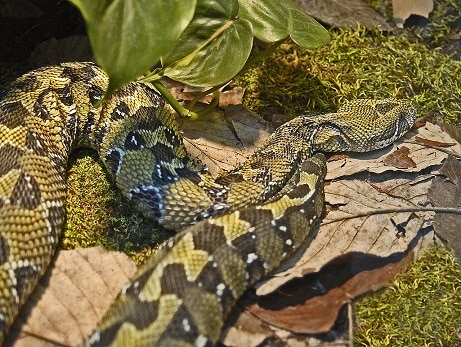
An Ethiopian venomous snake which is relatively poorly researched. Bitis parvicola frequents hills and wooded areas in the Ethiopian countryside, sometimes bordering forests. It’s especially common in western Ethiopia, and occupies altitudes of 1700-2800 metres.
Bitis parvicola’s thick body makes them particularly proficient at blocking hiking trails, where they can settle in for a long time. This is one of the thickest non-constrictors. Their strategy is to pounce on prey, and inject their venom while they’re startled and shocked. Bitis parvicola has moderately lethal venom, with especially powerful haemorrhagic abilities.
This is not a snake you want to become bedfellows with, but their liking for installing themselves on paths and doing absolutely nothing makes it a real possibility. For if you accidentally nudge one with your foot, that inertia will shift to blindingly fast action in mere milliseconds.
Running and jumping over this snake is risky, particularly if the Ethiopian mountain adder is less dozy than it looks. Standing back is safe, as this is a slow and steady species, except when striking at a random leg. Turning back might be your only safe choice, and that might secretly be what the Ethiopian mountain adder hopes for, as this snake actually prefers peace to war.
| 2 | Bothrops monsignifer |
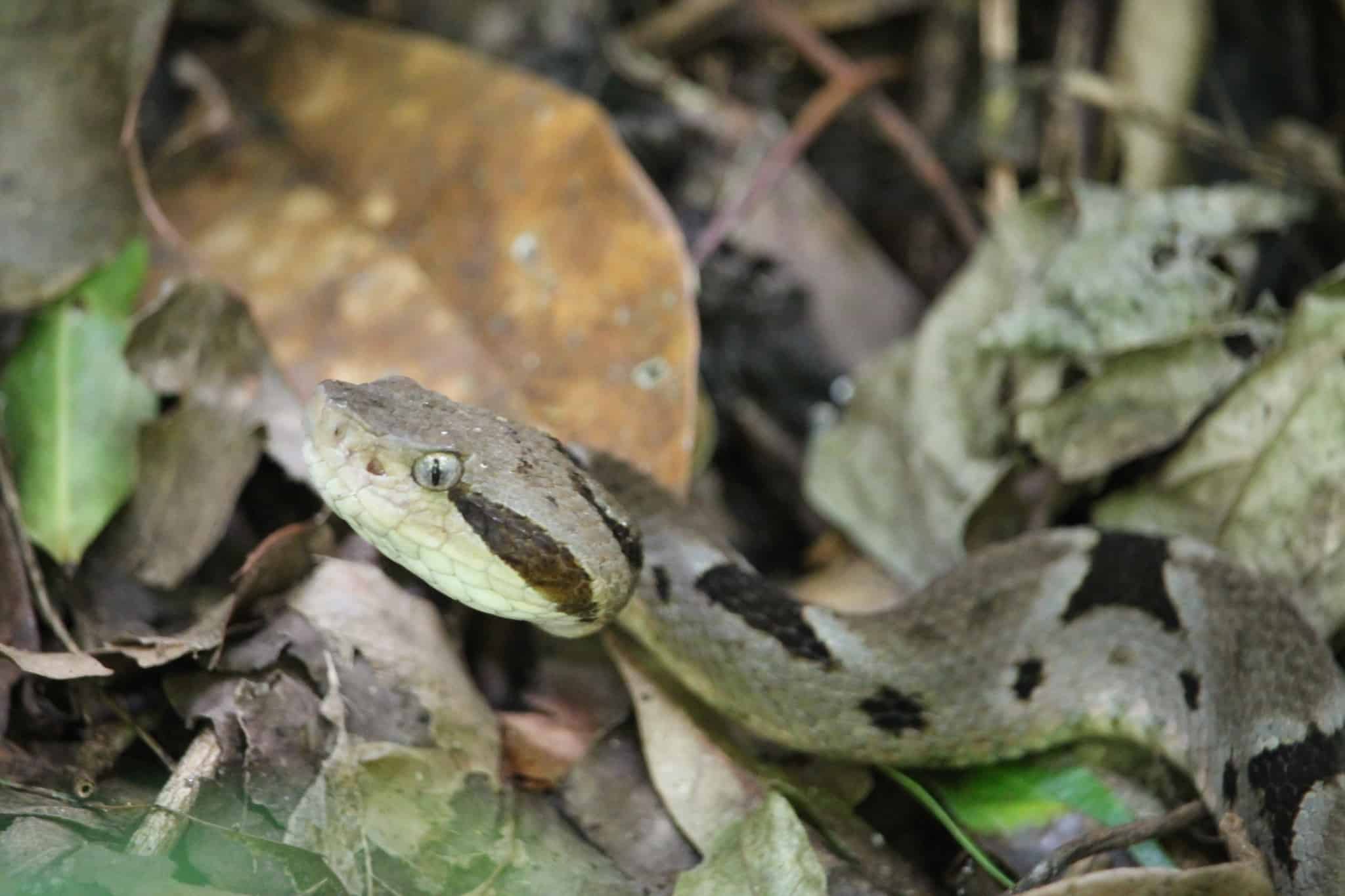
This dangerously venomous snake inhabits the eastern slopes of the Andes in Peru and Bolivia, at altitudes of 890–2133 metres, potentially higher. Bothrops monsignifer can reach 164cm, and mainly inhabit relatively open forests rather than dark, twisted ones. Encountering one on footpaths within forests is very likely, possibly during their thermal regulation, while they soak up valuable rays of sunlight.
With their liking for mountain trails, encountering this snake could spell absolute disaster for your day out. You could be in a secluded national park, walking down the sole trail through a forested valley. Suddenly, you meet a Bothrops monsignifer draped along the path, and your way forward is completely blocked. You’re in the middle of nowhere, and there’s no other option but forward.
You might then attempt to climb down and around the path, but plummet off a 500 metre cliff instead, meaning that the snake has still won. The other possibility is that you’re on the upper route and know that you have 5 minutes to go, but get blocked by an angry Bothrops monsignifer at the last second. Your only hope is to reverse out and head to the lower route, resulting in an extra hour of walking despite being just 1000 metres from the car park.
| 3 | Northeastern hill krait |
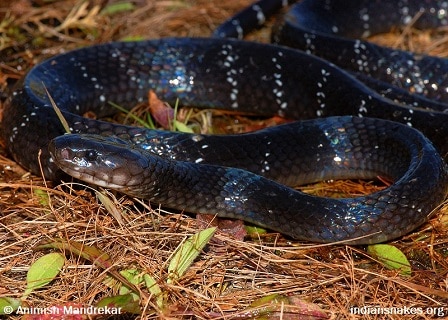
A neurotoxic snake which inhabits northeast India, eastern Nepal and Bhutan. If there’s any snake which blocks mountain trails out of pure maliciousness, then it’s the northeastern hill krait (Bungarus bungaroides). This is a venomous species which thankfully can’t spit venom, but has a neurotoxic bite which is a mere sneak preview to the main event of gradual body paralysis and laboured breathing. Bungarus bungaroides reach 1.45 metres, and inhabit low forests in the foothills of the Himalaya. A trail through a national park certainly isn’t out of bounds, and having your way blocked is no joke, as Bungarus members are more than capable of killing.
You might have to turn back, but then there’s another obvious option: run and jump, in an almighty leap of faith. With enough speed, you can clear the coiled serpent, and just get your Achille’s heel clear as the vicious snake strikes, missing by centimetres. Good footwork is required for this leap, as you don’t want to step on the snake and slip over tragically. Take a deep breath first.
There’s also tree roots to consider; tripping over and landing with your face right next to the snake’s mouth won’t end well. Success might depend on if you dither for too long. If you stood around for 10 minutes, yelling and debating, pointing at maps and flapping around like a headless chicken, then the snake may have taken notice. They might be fully prepared for your leap of faith, and ready to spring up and thwart all your dreams of survival.
| 4 | Large-eyed bamboo snake |
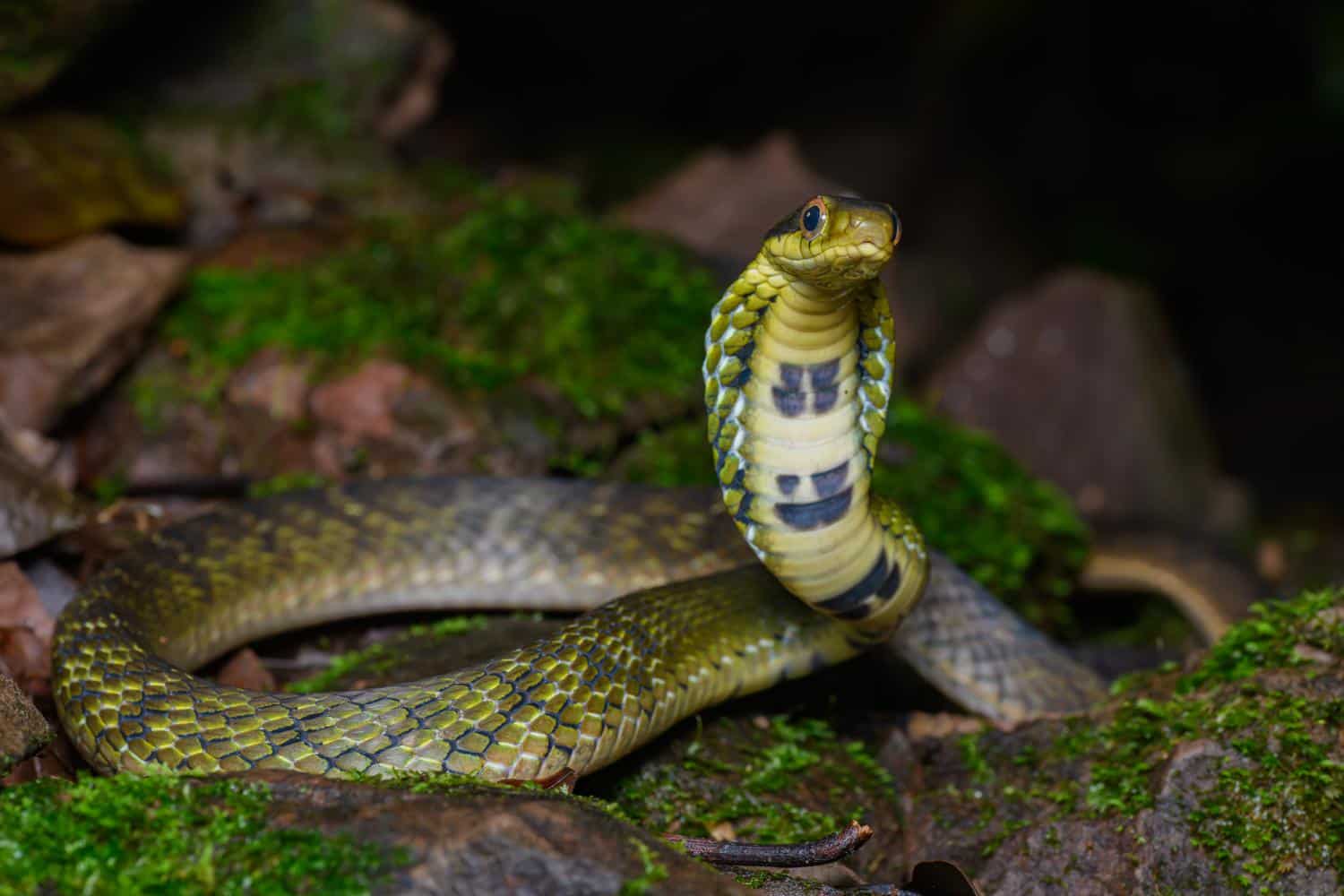
The large-eyed bamboo snake inhabits Thailand and southern China, where it inhabits forested hills with cool temperatures, at altitudes of 1200 metres and higher. It’s normally an energetic snake, exploring and following secret trails, to find its amphibian prey. But sometimes, it will curl up and rest for inexplicable reasons, and sometimes this happens to be on a popular footpath, blocking people’s way forward.
This isn’t a famous snake, and with a large spreadable hood, the majority of people will confuse them a deadly venomous cobra. This snake only has a mild venom, but they do have one other skill: the power to send entire groups of tourists scattering.
The large-eyed bamboo snake probably has no idea of the chaos they’re about to unleash when they settle down on a mountain trail. All they want is to bask in the golden glow of the sunlight, and relax for two hours while they digest their successfully caught amphibian. One day this might be on a mossy log in the woods, while a week later it could be on a hiking path popular with families. The large-eyed bamboo snake has no comprehension of human landmarks like benches and signposts, and simply goes wherever it’s finely honed serpent instincts tell it to.
| 5 | Forest cobra |
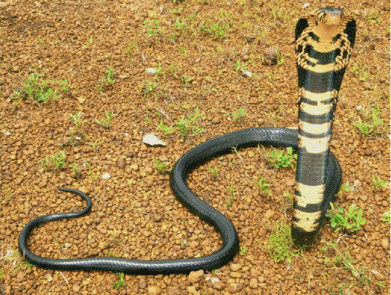
A dangerously venomous snake of central Africa, which reaches the highest altitudes of any African cobra (2300 metres). Forest cobras eat mammals, and also fish, and stay well away from towns and cities. They subdue prey with a paralysing neurotoxic venom and the yield per bite is large at up to 571mg. Forest cobras are abundant in high altitude forest reserves, and can be locally common, making it inevitable that they block people’s way forward on hiking trails.
When they raise their chest and hiss with an unbroken stare, it’s like they know exactly what they’re doing. The forest cobra has taken control of the path, and it won’t let anyone go down it as long as they live.
The reason doesn’t matter, at least until its reptile brain gets distracted and moves onto the next task. This is the best hope with the forest cobra. They might be stubborn as a mule and determined to ruin your day, but they’re also twitchy and hyper. This snake has ADHD, and it’s less likely compared to a viper that they’ll take hours to move on.
| 6 | Andean pitviper |
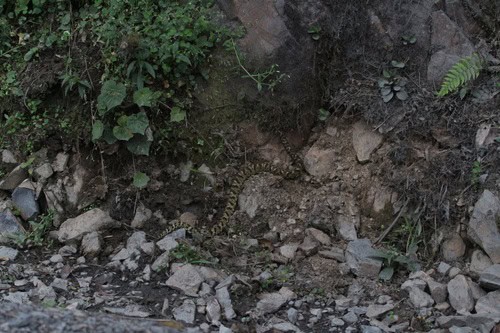
It’s a path you’ve enjoyed many times before, but this time there’s a difference: an immobile serpent blocking the way. The Andean pitviper (Bothrocophias andianus) lives in Peru and Bolivia, lurking in dark forests in a large stretch of the Andes. This dangerous viper nearly always sticks to the ground, rarely climbing trees.
This is a doubly tricky snake, as its camouflage is so excellent that you may not realise its true nature until your feet are just inches away. Bothrocophias andianus measure up to 125cm, and have glistening brown-beige scales which blend superbly with moist forest trails. On a long, winding expedition through the remote Andes, you too could fall for this. You might also step on the snake, look down and jump back in horror, having a mild heart attack in the process. Or the shock could be enough to propel you forward and over the snake, instantly solving the problem.
Alternatively, you could step over the snake obliviously, walk away and never realise that you met an Andean pitviper to your dying day.
| 7 | Hodgson’s ratsnake |
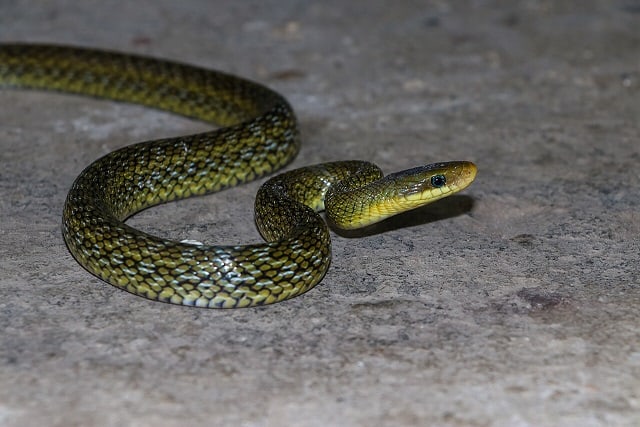
A hard snake not to notice as you walk up innocently and find it blocking your way. Hodgson’s ratsnakes range from northern India to Nepal, and live only above 1500 metres, in endless rows of Himalayan foothills. They’re a non-venomous snake which usually flees when encountered, but could turn vicious if you push the correct buttons.
Another name for this snake is Himalayan trinket because of their abundance there, and while forests are their favourite, with plenty of vegetation, they also spend time in open areas to absorb sunlight, like footpaths. The average person could leapfrog a Hodgson’s ratsnake, but to a ophiophobe, the idea of running and jumping might be horrifying.
Patience is another option for this Nepalese serpent, as you could stand back and pray that it moves on in a minute or two. The snake might have been there for hours, and feel toasty and warm, and decide to leave. But it may have begun its basking session just 30 minutes before you arrived, in which case you’d be in for a long wait. The snake could raise its head and look around alertly, as though about to shoot off, giving you false hope, before slumping back down to the warm ground again.
| 8 | Mangshan pitviper |
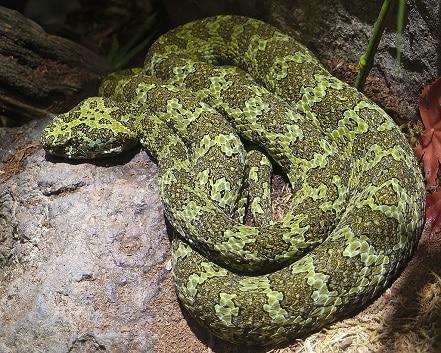
This is such an odd snake that it might be hard to recognise what you’re seeing as first. Mangshan pitvipers inhabit the mountains of southern China, and reach up to 200cm. Their patterns are a lime green overlaid on mossy green, giving them the appearance of a slimy riverside boulder come to life.
Mangshan pitvipers love to lurk in crevices in jumbled rock piles, but become more adventurous at night, venturing closer to the trails frequented by tourists or maybe hikers, Mangshan pitvipers are a very obscure species, and anyone who skipped their research before setting out that morning could be confused. It’s a green, mossy serpent just lying there on the path. It doesn’t seem too energetic, but is it venomous or not? Coupled with the chirping of insects and high humidity, this snake would be capable of inspiring great unease. It’s a completely unknown life form.
Fortunately, this is a slow-moving snake. With a rapid dash and leap, you should be OK, particularly with thick, heavy boots. But some snakes can strike unbelievably quickly, despite a generally sluggish appearance. Mangshan pitviper venom is poorly researched too, though confirmed to be strongly cytotoxic.
| 9 | Godmane’s montane pitviper |
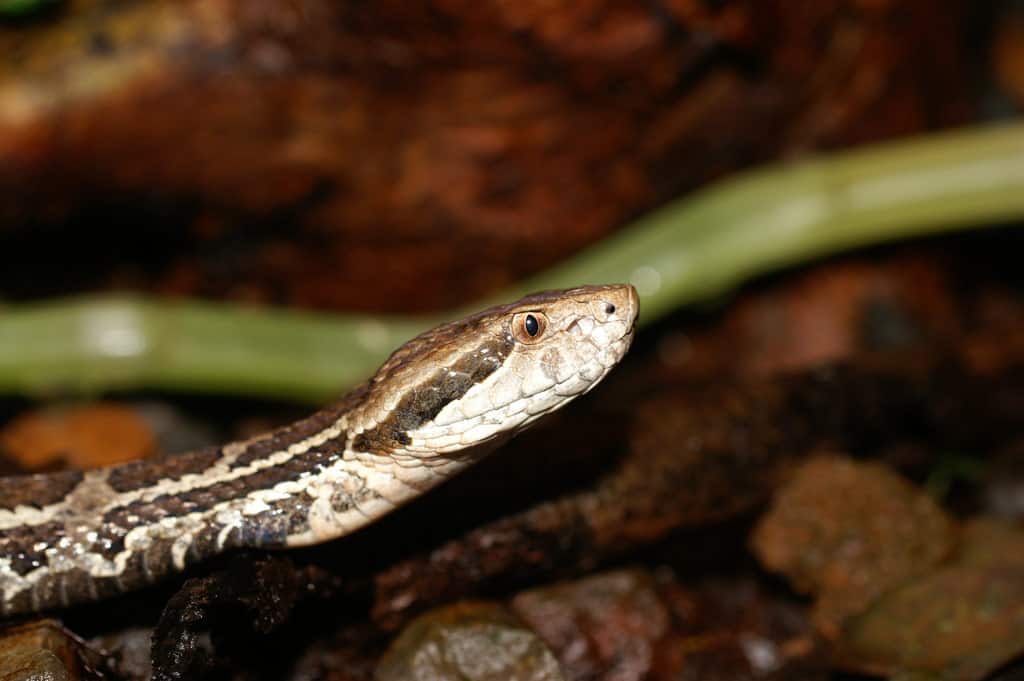
A venomous snake of southern Mexico and Guetamala, which produces a powerful anticoagulant venom, cleaving directly through fibrinogen. You wouldn’t want to place your ankle directly next to its fangs, and make its tendency to block hiking trails all the more troublesome. Godman’s montane pitvipers prey on brush mice and spiny lizards, and are a cousin of Costa Rica’s Wilson’s montane pitviper.
Cool mountainous paths are the most common place to meet Cerrophidion godmani, and encouraging one to move could be very tricky. You wouldn’t want to hurt the snake, and if you threw a rock, you could cause serious damage. If it missed, the snake probably wouldn’t notice a thing, as they can be quite dimwitted. A gentle push with a stick would be wiser, but that’s assuming you have one ready. Even in a luscious pine forest, finding a proper sized branch can be harder than you’d expect.
A water bottle would be your best bet; splashing some harmlessly on the snake’s back would jolt it harmlessly out of its stupor, particularly if it was basking in the sunlight. Of course, this might enrage the snake as well, in which case you’d be out of the frying pan and into the fire, particularly if it’s the venomous Godman’s montane pitviper.
| 10 | Sri Lankan hump-nosed pitviper |
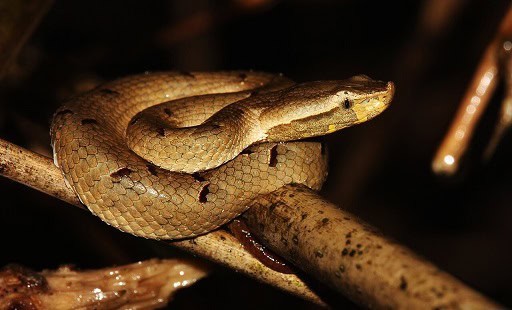
A forest snake which is always prowling around hills and rocky slopes, but sometimes settles down on one spot for hours. Hypnale nepa lives exclusively in its namesake island, favouring high altitude areas in central Sri Lanka over 1250 metres. They have no desire to block long, winding hiking paths, simply wishing to relax and digest that week’s meal, or absorb sunlight. Yet block people’s progress is exactly what they do. Sri Lanka has over 40 endemic snake species, and no matter how much humanity thinks they’re in control, nature will always bite back occasionally.
Sri Lankan hump-nosed pitvipers may love to block paths, and usually move slowly, but they can flee rapidly as well. With the right snake-charming manoeuvres, you could get rid of the roadblock without ever needing to draw close. Clapping your hands might work, but also whistling or bird caws or weird noises that the snake is sensitive to.
You can recognise Hypnale nepa by its namesake hump snout, and brown-beige colours rather than green. If in doubt, it’s smartest just to turn back and find a new route, because this species is easily capable of killing via acute kidney injury.
